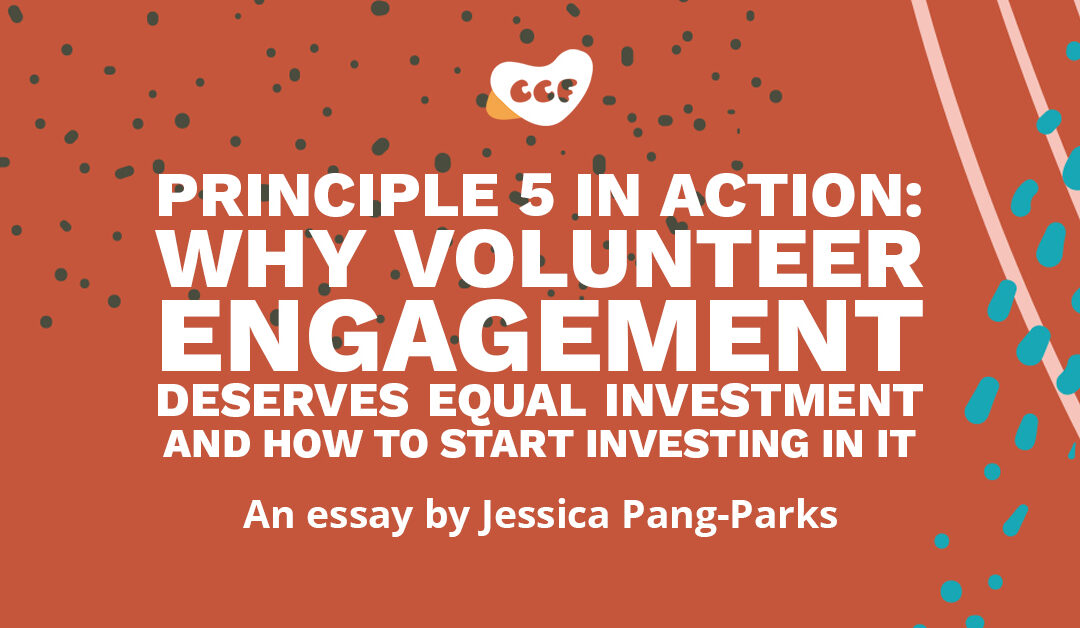By Jessica Pang-Parks, Advocate for volunteerism and volunteer engagement — helping nonprofits build trust, create impact, and inspire belonging
A key reason I was drawn to Community-Centric Fundraising (CCF) is Principle 5: Time is valued equally as money. Yet, in most nonprofit organizations, volunteer engagement is not valued as equally as donor engagement.
It was a Monday. The senior fundraiser, who had barely acknowledged me prior, made a remark—definitely not a request: “I need fifteen volunteers for the golf tournament on Thursday.”
I explained that volunteer recruitment is a process that typically takes six to eight weeks. In the volunteer engagement cycle, planning comes before recruitment. I asked when their team had started planning the golf tournament. They ignored my question and simply said, “Just do your job.”
Taken aback, I calmly clarified that my job was to be a strategic fundraising partner, an internal consultant, and a professional subject matter expert. The senior fundraiser rolled their eyes. “Don’t you have a pool of high school students who need their service hours?” they asked.
I continued to keep my composure as I illustrated why maintaining a volunteer pool was poor practice. Volunteer schedules and goals shift constantly, and just like donor stewardship, volunteer stewardship should be personalized.
I then posed a question: “As a parent, how would you feel if your teenager was asked to take time off school to volunteer at a golf course—one that’s inaccessible by transit and where alcohol will be served?”
They rolled their eyes again and dismissed me from their office.
I promised to follow up with a volunteer role description template and timelines for future requests. But inside, I was seething.
As a volunteer engagement professional, I’ve had countless conversations like this. I’ve advocated for policies that improve the volunteer experience, build trust, and mitigate organizational risk. I’ve pushed to be included in project planning meetings, knowing that down the line, colleagues would come asking for volunteer support at the last minute. I’ve had difficult discussions about what constitutes decent volunteer work—like the time I convinced a colleague to remove a volunteer posting for “office janitor.”
A key reason I was drawn to Community-Centric Fundraising (CCF) is Principle 5: Time is valued equally as money. Yet, in most nonprofit organizations, volunteer engagement is not valued as equally as donor engagement.
For most of my career, I worked in volunteer engagement at large, national charities in Canada, supporting fundraisers and fundraising initiatives. When I joined these organizations, I’d look at the org chart and see dozens, sometimes hundreds, of fundraising colleagues—each with a specific role: events, major gifts, donor relations, data, legacy giving, etc., all ultimately accountable to a Chief Development Officer or VP of Fundraising.
Then, I’d look for the volunteer engagement team. Most times, it was just me. Occasionally, I’d have colleagues in other provinces or on specific projects. And who did we report to? Usually a leader in fundraising, communications, mission, or HR—not an executive dedicated to volunteer engagement.
What the stats say.
Through my involvement in volunteer engagement associations for over a decade, I’ve learned that this is the norm. Volunteer engagement professionals are often the only ones in their organization doing this work and frequently have more expertise in leading volunteers than their managers.
In 2024, Volunteer Toronto identified a “critical gap in volunteer management staff and skills” among nonprofits, leading to what many mistakenly call a volunteer shortage.
I’m not surprised. Many of my peers have left the field for communications, fundraising, or operations roles—because the wages for volunteer engagement professionals are simply too low.
A 2017 study by the Minnesota Alliance for Volunteer Advancement (MAVA) compared nonprofit executives’ perceptions of volunteer engagement professionals versus their fundraising, HR, and programming counterparts. The findings were frustrating, though not surprising. Volunteer engagement professionals were less likely to serve on an executive leadership team and had lower salaries than their fundraising, HR, and programming counterparts. And they were expected to have more experience in community partnerships, personnel management, communications, public speaking, database tracking, and program development than fundraisers or HR professionals.
I didn’t have this data when former managers justified my lower salary by saying, “You don’t bring in revenue.” But I wish I had.
Even setting aside CCF, good volunteer stewardship directly increases revenue. A 2024 study from the Do Good Institute at the University of Maryland found that people who volunteered in the past year were 14.5% more likely to donate in the current year. If you compare your own nonprofit’s donor data, you’ll likely find that donors who volunteer give more frequently and in higher amounts than those who don’t.
Volunteers contribute their most valuable, non-renewable resource: time. They, and the professionals who steward them, deserve decent work.
What Can Nonprofits Do?
If your organization is serious about Community-Centric Fundraising, consider these actions:
- Hire and support dedicated volunteer engagement professionals who specialize in ethical stewardship of time, talent, testimony, and ties. Certified Volunteer Administrators (CVAs) are bound by core ethical values: citizenship, respect, accountability, fairness, and trust. The Aphasia Institute promoted a longtime volunteer engagement leader from coordinator to manager of volunteer services, and supported their CVA journey.
- Include volunteer engagement professionals in strategic planning and executive discussions.
- Compensate volunteer engagement professionals equitably and recognize their contributions to fundraising wins.
What Can Fundraisers Do?
If you are ready to advocate for volunteer engagement colleagues, consider these actions:
- Build stronger relationships with volunteer engagement professionals by inviting us to share our expertise with your team, and making time to exchange ideas and discuss collaboration on an ongoing basis.
- Ask leadership critical questions:
- “Why does the manager of volunteer engagement report to the director of philanthropy?”
- “Why isn’t there a director of volunteer engagement?”
- “Why is one person stewarding thousands of volunteers, while dozens of fundraisers steward a similar number of donors?”
- Recommend talents and experiences of volunteer engagement professionals at tables where we are not yet invited.
- Educate yourself on volunteer engagement. Beyond CFRE exam prep, check out:
- Vantage Point’s From Strong to Abundant (on workforce integration for volunteers at all levels).
- The Equity in Action Toolkit (on fostering volunteer belonging across the engagement cycle).
- Engage Journal (on global volunteering trends and issues).
If we want to transform philanthropy together, community-centric fundraisers must walk the talk of Principle 5. That means valuing time as equally as money—not just in theory, but in action.

Jessica Pang-Parks
Jessica Pang-Parks (she/her) has the privilege to work as a community and volunteer engagement consultant on the traditional land of the Huron-Wendat, the Seneca, and the Mississaugas of the Credit. Learn more about Jessica at www.learnwithjpp.com, connect with her on LinkedIn, and leave a tip to support her thought leadership.
Discover more from CCF
Subscribe to get the latest posts sent to your email.

